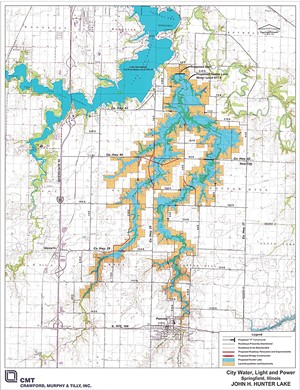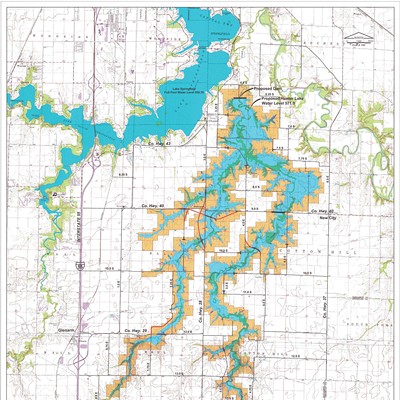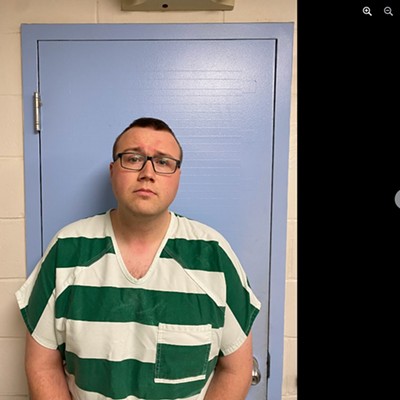
For 55 years, the city has neglected Lake Springfield, refusing to dredge in hopes of building Hunter Lake, an unneeded, expensive and environmentally destructive monument to the Langfelders' legacy. It would destroy historical wetlands, hundreds of acres of mature forest, endangered species habitat, two streams and hundreds of acres of farms, eliminating nearly 10% of the remaining forests in Sangamon County. The project has repeatedly failed to pass regulatory muster. This fourth try after wasting millions of ratepayer dollars should, too.
The Army Corps of Engineers (ACE) published CWLP's Supplemental Environmental Impact Study for the project on Aug. 11. Drafted by CWLP's paid consultant who promised to deliver Hunter Lake as the preferred alternative in advance of any required studies, it is no surprise the SEIS delivers what CWLP paid for – Hunter Lake. ACE allows until Sept. 25 to submit written comments to: [email protected] .
ACE will host a public meeting at Lincoln Library on Sept. 6 from 5-7 p.m. to facilitate comments, but before that, Sangamon Valley Sierra Club hosts a comment drafting workshop at the Illinois Environmental Council office on Aug. 30 from 5 -7 p.m. for opponents of Hunter Lake.
Hunter's opponents have already had an effect: the proposed lake is redesigned, 43% smaller capacity-wise, with a somewhat smaller footprint, sparing some of the vast destruction of the previous designs CWLP's contractor called excessive and fundamentally flawed. Additional mitigation is proposed, and it is supposed to trap phosphorus-laden sediment behind two smaller upstream dams CWLP labels "pollution control devices" to try to get away with impounding phosphorus-polluted water.
Such improvements are proverbial lipstick on a pig. For decades, CWLP has trumped up figures to "prove" the need for an additional 12 million gallons of water per day during the 100-year drought, the same amount claimed in 2016, when the application was renewed. But CWLP admits that closing three old water-intensive coal plants left Lake Springfield 9.9 million gallons per day more water in a drought than before.
When the plants were scheduled for retirement (2018-19), CWLP and Mayor Jim Langfelder, realizing a big problem, came up with adding recreation as a "need." When ACE noted the law required CWLP to justify the need, noting that at no time in 30 years had they claimed project need as anything but "supplemental water," the city squabbled for many months, delaying the SEIS until finally conceding, then blaming ACE for delays. CWLP then paid $25,000 for a study that concludes there is such extreme demand for more flatwater recreation that five new lakes are needed within 50 miles of Springfield.
The recreational need, manufactured once water supply need was rendered doubtful, is unsupported.
Aside from the ludicrous "five more lakes" conclusion, it's merely based on a survey of 625 people, almost 70% of whom said existing water-based recreation was adequate. The study failed to examine actual usage at even one of 45 different lakes and rivers within 50 miles. Opponents did, at the closest lake (Sangchris, a five-minute drive from proposed Hunter Lake), and data proved gross underutilization of water recreation.
Despite 9.9 million gallons per day more in Lake Springfield now than 2016, CWLP still won't concede there's no justifiable need for supplemental water, claiming instead that high population growth (eschewing census data showing population decline), new wholesale water needs, big industrial growth, adding a new water-intensive fossil fuel plant, and other unsubstantiated factors still justify the 12 million gallons per day claim. CWLP compounds demand-side errors on the supply side, falsely claiming Lake Springfield's yield is only its top 13 feet and refusing to dredge it to add another 4.8 million gallons per day in a drought.
CWLP gives short shrift to better, cheaper, less-destructive alternatives even if ACE agreed more water or recreation is needed, including gravel lakes east of Springfield CWLP admits produce 7.4 million gallons per day in a severe drought, without counting millions more available because these lakes are directly connected to the Sangamon River.
CWLP surrendered its longstanding permit to construct a temporary dam on the Sangamon River in a 100-year drought, an alternative considerably less expensive that may never have to be used, and if needed would have only short, limited environmental impacts.
CWLP rejected using Sangchris Lake water, though Vistra Energy is abandoning the Kincaid power plant, leaving more for CWLP's pump station on the South Fork. CWLP unreasonably rejected and failed to adequately study every feasible, cheaper, less-destructive alternative in order to justify Hunter Dam.
If after reviewing public comments, ACE decides if Hunter Lake is in the public interest, and if needed, whether it is the least-costly alternative that can meet defined needs at the lowest cost and with the least environmental damage, there is another step necessary. If a permit is issued, the City Council still must decide whether to proceed.
Don Hanrahan, a Springfield attorney, is political chair of the Sangamon Valley Group of the Sierra Club and a longtime opponent of Hunter Lake.


















